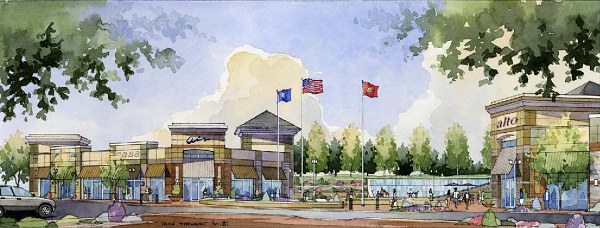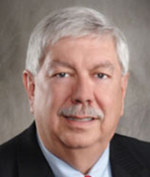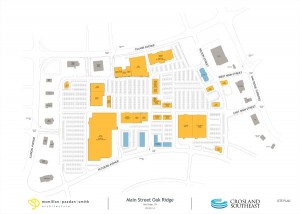Council, IDB approve TIF extension, grant, roadway work
The proposed redevelopment of the Oak Ridge mall cleared a critical hurdle on Monday when city officials agreed to extend a property tax agreement for the 59-acre project, authorize $2 million in roadway and other infrastructure work, and offer a $500,000 grant if some federal funding is not approved.
Officials described the proposed redevelopment, named Main Street Oak Ridge, as an $80 million project that could fill a “hole in the heart†of Oak Ridge, bring new retail life to the city’s downtown, and build a lasting legacy.
Monday’s moves were meant to reduce the risk for four local lenders that could combine to offer $13 million in loans to part of the redevelopment under a tax increment financing, or TIF, agreement. That incentive would use new property tax revenues generated at the mall site and 120 surrounding acres included in the TIF area to repay those loans. Officials said the loans could be repaid in 18 years, according to financial models.
But in two separate special meetings on Monday, the Oak Ridge Industrial Development Board and Oak Ridge City Council agreed to extend the TIF term from 20 years to 30. That extra 10 years is meant to act as a “shock absorber†and help make sure that the banks are repaid if there is a “glitch†in the project that would push the repayment past the previously approved 20-year term, officials said.
“This is not a ‘home run’ project for us as financial institutions,†said David R. Bradshaw, Oak Ridge president of CapitalMark Bank and Trust, one of the financial institutions that could participate. But, he added, “It is the right thing to do for the community.â€
City officials and project executives described the redevelopment as complicated. It’s not a typical “greenfield” project, Oak Ridge City Manager Mark Watson said, because it includes demolition and rebuilding. But he said property values at the mall site, where previous redevelopment efforts have failed, have dropped from about $60 million in 2002 to $6 million today, and the city might have lost some $5 million to $6 million in sales tax revenues.
It’s time to turn that around, city officials said.
“We’ve basically been a city with a hole in our heart,†Watson said. “It’s time to fill that hole.â€
City officials have repeatedly expressed optimism that, if anyone can successfully redevelop the mostly empty mall property, it’s Crosland Southeast, the North Carolina firm that has had a purchase contract on the site since January 2013.
Tim Sittema, a partner in Crosland Southeast, said developers have whittled down the list of main issues from 2,000 a few years ago to two today. He said the TIF financing was a big hurdle, and he was more optimistic after Monday’s votes.
“Without that, the project would have been dead,†Sittema said of the TIF financing.
The local lenders haven’t agreed to make the TIF loans yet, though. They have to be approved by loan committees, Bradshaw said. Crosland Southeast hopes to have answers within about a month.
The original 20-year TIF was endorsed and approved by Oak Ridge officials and Anderson County officials last fall and approved by state officials this winter. The revised TIF term could be considered by the Anderson County Commission in October.
Sittema said the other remaining issue is site leasing. He said Crosland is negotiating leases and letters of intent with potential tenants representing more than 70 percent of the retail space at Main Street Oak Ridge.
“We’ve made significant progress,†Sittema told the City Council, saying he is pleased with the potential tenants and the volume of prospective retailers.
He said demolition could start in the first half of 2015, and new stores could open in the middle of 2016. A site plan published last week shows a mix of anchor stores, smaller “junior†retailers, large and small shops, restaurants and retailers, and outparcels. The existing enclosed space between the two remaining anchor stores—Belk and JCPenney—would be demolished, and Main Street Oak Ridge could contain about 400,000 square feet of retail space in multiple buildings, up to 100,000 square feet of office space and a hotel, plus the construction of up to 50 multi-family residential units.
The IDB approved the 10-year TIF extension in a 6-0 vote on Monday. IDB Secretary and Treasurer Chris Johnson abstained. Johnson is president and chief executive officer of ORNL Federal Credit Union, one of the potential local lenders.
A few hours later, the City Council approved the extension in a 6-1 vote.
“Retail is needed in Oak Ridge, and it is going to have a lot of benefits,†Oak Ridge Mayor Tom Beehan said. “I’m very supportive and happy to see that we are finally here.â€
“This is a legacy issue, as far as I’m concerned, for this city,†Council member Charlie Hensley said. “This is a community project. It’s a team effort.â€
Council member Trina Baughn cast the lone “no†vote. She said she had to look at the deal from a risk mitigation standpoint.
“We’re in essence putting all of our eggs on the sales tax revenues,†Baughn said. “We need to be very careful about how far we’re going to extend our risk so we don’t make the mistakes we’ve made in the past.â€
Responding to a citizen question about public risk later in the meeting, though, attorney Mark Mamantov, who helps the city on tax incentive deals, told Oak Ridge officials they would have no obligation to pay the project debt.
“You have no legal responsibility to pay for it if there is a shortfall,†he said.
The IDB approved the $500,000 infrastructure grant in a 5-1 vote, with Johnson abstaining again and board member Dave Mason voting “no.” The IDB grant would be used as a financial “backstop†if the city does not get a $1 million federal grant from the U.S. Department of Commerce Economic Development Administration. Mason had asked how the IDB grant to the mall project might affect the city’s ability to provide power to parcels at the Horizon Center industrial park in west Oak Ridge.
Besides Mason and Johnson, IDB members present at Monday’s meeting were Chair David Wilson, Vice Chair Buzz Patrick, and board members Harold Trapp, Richard Chinn, and Lou Dunlap. Board members Hal Osucha and Melissa Freiderich were absent.
The public infrastructure improvements later approved by Council in a 6-1 vote—Baughn again voted “noâ€â€”would include the rebuilding of three private roads: Main Street East, Main Street West, and Wilson Street. In addition to rebuilding those private streets to public road standards, the improvements would also include the relocation and placement of underground power and communications lines along Rutgers Avenue between Walmart and Wilson Street. The total estimated cost of that project is $2 million, with $1 million of that coming from $800,000 in reserves and $200,000 from the Fiscal Year 2015 Capital Project Funds.
The remaining $1 million would either come from an EDA grant, or the $500,000 IDB grant and $500,000 from TIF proceeds.
“I want to see this project succeed,†Baughn said. “I really do. But this is a great deal for the developer.â€
Sittema disagreed.
“This is not a ‘fat deal’ for anybody,†he said. “This project is a very difficult project.â€
But, he added, “We’re committed to trying to make this happen.â€
Watson said Crosland Southeast has already gone through more than 50 project designs and spent hundreds of thousands of dollars. He said a successful renovation of the mall property would encourage a “tremendous return of shoppers.â€
That was a line echoed by City Council member Anne Garcia Garland.
“We’ve lost volumes of sales tax to Turkey Creek, West Town…shortly to Hardin Valley,†she said, referring to shopping centers and communities in neighboring Knox County.
Main Street Oak Ridge could attract shoppers to the city that are now going elsewhere, Garcia Garland said.
A TIF has previously been used in Oak Ridge, although on a much smaller $600,000 scale, at the Woodland Town Center on South Illinois Avenue.
See the Monday night City Council meeting agenda and mall resolutions here.















Joseph Lee says
6-1 vote, big surprise. This is great news for Oak Ridge.
Dave Smith says
As you know, there were two votes, each resulting in a 6-1 approval of the TIF extension and the infrastructure improvements. That there was a single naysayer was no big surprise, either. Indeed, it was a voice crying out from the wilderness.
WK Hyatt says
I agree with the vote, time to move forward on retail, the market is there, always has been. People all the way up State Route 62, US 27 and here in Oak Ridge won’t go to Turkey Creek if there is something on the shelves here, Right now, since there is not, they blow right on by us. Lets break dirt and get this started.
Also, its time to go after some light industry, manufacturing here, not necessarily high tech, but good jobs at good rates, we have the Industrial Park and K-25 Site, lets get some plants in there.
Jeanne Hicks Powers says
Way to go,OR! Looking forward to seeing it all begin.
Trina Baughn says
It is inconsequential at this juncture, but perhaps we will learn something from our past in the future. I hope that the visionaries are successful and that I am proven wrong about my vote.
http://trinabaughn.com/2014/10/02/the-peoples-business-92914-special-meeting-mall-tif-changes/
David Allred says
You have more confidence in the future than I do, although let’s be honest – the nation will probably be crushed by its debt before the city. Like you mention in your blog, over a trillion dollars in student loans should be enough to raise a red flag now, but it isn’t. As long as Uncle Sam keeps printing money and the Ivy League educated pinheads keep forgetting how to balance a checkbook, we’ll keep getting deeper in the hole.
Many big malls around the country are struggling as buyers shift from shopping in person to online purchasing. Heck, even Barnes and Noble closed up shop. Twenty-five years ago, Oak Ridge put a roof over a very open shopping space just as shoppers were moving from the closed-in venue of West Town and East Town Mall to the open Turkey Creek style environment. Now, we’re twenty years too late once again and you can bet by time we retire in a couple of decades, shoppers will be having their perfumes and dress pants delivered by drones to their front door, once again leaving a hole in the heart of the city.
Ellen Smith says
I don’t share your cynicism about this project. I think the new design will have a lot more staying power than the mall ever did.
In some respects, this is a case of fashions going full circle. The old Downtown Shopping Center (which was replaced by the Crown American’s “Oak Ridge Mall”) had a good bit in common with today’s fashionable lifestyle centers. Too bad we can’t wave a magic wand and get it back. But Oak Ridge succumbed to the mall fad, then the mall itself succumbed, and it turned out to be far more difficult to reclaim a dead mall than it was to build it in the first place. Main Street Oak Ridge won’t be the reincarnation of Downtown Shopping Center, but it will have a closer resemblance to Downtown than it will have to the Crown American mall.
I agree that bricks-and-mortar retail is struggling (that’s one reason why the Main Street Oak Ridge project won’t have nearly as much retail space as the mall had), but I don’t see it going away completely. For one thing, recent conversations have confirmed for me that many people still crave the in-person shopping experience. I hope that Main Street Oak Ridge helps satisfy their cravings. And I know that families with growing children have a real need for local stores — because (to give one example) it doesn’t work to go online to buy new shoes for a 10-year-old boy.
David Allred says
I struggled a bit with the word cynicism before deciding it was a fair word. I feel like I have a healthy skepticism, that invariably finds itself a little too close the ledge of cynicism and I am willing to admit that’s a ledge a reach more often than not when it comes to our economic futures as American citizens.
Ironically, yesterday I read three Facebook posts from people who really wouldn’t have any reason to know each other or have read each other’s posts. All three were blistering complaints about our local Walmart. I’m not sure if being a Thursday, maybe Walmart was cutting back on the potential for overtime at the end of a work week, but all three said they waited in 20 minute + lines yesterday and had no intention of going back there.
So on the one hand, I am confident that more options will be a good thing. I just wonder about my generation (and even younger) who’ve already decided we can get better deals online and tend to shop in our pajamas if given the opportunity.
Then there’s just the track record on economic decisions both locally and nationally, which if we’re all honest, isn’t very good. Like I said, our decisions have historically lagged about 20 years behind what’s happening in other places. Could that be because our median age in Oak Ridge is considerably older? I think maybe so.
Then finally, there’s the housing issue which is several degrees more serious than our lack of retail. If we build a shining new town center and expect it to draw taxpayers, where will they live? Mariner Point or Hardin Valley as they do now? I think probably so — at least until we get our housing issue under control in Oak Ridge.
I’d echo Trina and say I hope I’m wrong. I’ve seen this sort of thing work before. We lived in Rome, Georgia while my wife did her residency for licensure in psychology. When we moved there, the city was very similar to Oak Ridge in population and retail. Ten years later, we returned for a wedding and barely recognized the city. A couple of amazing construction projects had been undertaken and city came back to life around them. I’m not sure what role the city played in making that happen — or if private industry saw an opportunity and seized it.
Part of me thinks if there truly was money to made here, the young capitalists would be at the gates with shovels in hand.
Mark Caldwell says
I share both your and Ms. Baughn’s thoughts.
I also hope you both are wrong.
P.S. I’m optimistic regarding the economic health of this country as well as Oak Ridge.
Joseph Lee says
Is it 2016 yet? I for one have heard enough from Ms. Baughn.
Trina Baughn says
Glad to see you showing more restraint these days, Joe! Keep up the therapy or the meds or whatever it is that’s calmed you down. 🙂
Joseph Lee says
Knowing we are in the last half of your last term is refreshing.
Thank you.
Trina Baughn says
Awe! It’s so touching to know that you take me with you when you go to your “happy place!” I always had you pegged as a rainbows and unicorns guy.